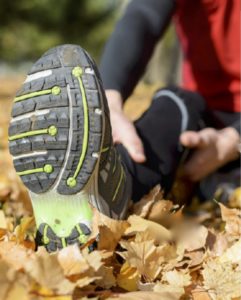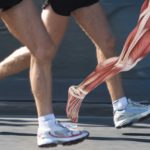ANATOMY OF OVERUSE INJURIES
By CEO Robert Forster, PT
Unless you fall down and break a bone or step wrong and sprain your ankle, the vast majority of running injuries you are likely to suffer are overuse injuries. Overuse injuries occur when we outpace our body’s ability to adapt to the stress of training. The micro-trauma suffered by the tissues during training, which would normally heal and make us stronger with adequate recovery, instead builds into a macro-trauma with back-to-back hard days and weeks of training.
By the time pain arises, the typical overuse injury may be weeks or months in the making. The injured tissue most likely had been struggling to heal for quite some time, but the repetitive stress of running stalled the healing process.
 The chain of physiological events that is put in motion to repair the damaged tissues begins with the inflammatory response. This is a characteristic reaction set in motion to first clean up the debris of the damaged cells and then begin the healing of the injured area with scar tissue.
These events are repeated throughout your body every time you run, and they go unnoticed if your training is progressive and designed with built-in time for recovery—and that means several recovery days every week, a recovery week every month, and some time off every year. You see, when your workouts are too frequent, or too hard, and go on for too long and with not enough time provided for recovery, the body struggles to stay ahead of the stress.
If the healing process from the microtrauma is incomplete and the scar tissue has not matured enough to withstand the stress of your next workout, it gets broken down and the process starts all over again. The problem then becomes one of excess scar tissue and chronic inflammation. The inflammation causes scar tissue, and the scar tissue causes dysfunction in the injured structure, which propagates more tissue damage and chronic inflammation, the inflammation causes pain, and the pain causes muscle tightness or spasm and more dysfunction in a circular downward spiral that eventually stops you in your tracks.
Face it: Running is so addictive that the most self-aware disciple of Periodization training can slip into overtraining and pick up an overuse injury if he or she gets a little distracted. That’s why it’s so important to be aware of the signs of overtraining—and then to do something about it. Step one in the recovery process is simple logic: Halt the damaging workouts. Then, find a pain-free cross-training modality and address the inflammation with aggressive icing. Next, relieve the muscle tightness with stretching and break up scar tissue with the foam roller or cross-fiber friction massage by a qualified professional.
The key is when you feel an injury developing, don’t delay. The sooner you start the recovery process, the sooner you’ll be back on the road.
Call Forster Physical Therapy at (310)656-8600 to schedule an injury evaluation.
To learn more about sustainable health and fitness practices based on your personal physiology, call (310)582-8212 or e-mail info@phase-iv.net to schedule your free Health & Performance Consultation with an Exercise Physiologist.
The chain of physiological events that is put in motion to repair the damaged tissues begins with the inflammatory response. This is a characteristic reaction set in motion to first clean up the debris of the damaged cells and then begin the healing of the injured area with scar tissue.
These events are repeated throughout your body every time you run, and they go unnoticed if your training is progressive and designed with built-in time for recovery—and that means several recovery days every week, a recovery week every month, and some time off every year. You see, when your workouts are too frequent, or too hard, and go on for too long and with not enough time provided for recovery, the body struggles to stay ahead of the stress.
If the healing process from the microtrauma is incomplete and the scar tissue has not matured enough to withstand the stress of your next workout, it gets broken down and the process starts all over again. The problem then becomes one of excess scar tissue and chronic inflammation. The inflammation causes scar tissue, and the scar tissue causes dysfunction in the injured structure, which propagates more tissue damage and chronic inflammation, the inflammation causes pain, and the pain causes muscle tightness or spasm and more dysfunction in a circular downward spiral that eventually stops you in your tracks.
Face it: Running is so addictive that the most self-aware disciple of Periodization training can slip into overtraining and pick up an overuse injury if he or she gets a little distracted. That’s why it’s so important to be aware of the signs of overtraining—and then to do something about it. Step one in the recovery process is simple logic: Halt the damaging workouts. Then, find a pain-free cross-training modality and address the inflammation with aggressive icing. Next, relieve the muscle tightness with stretching and break up scar tissue with the foam roller or cross-fiber friction massage by a qualified professional.
The key is when you feel an injury developing, don’t delay. The sooner you start the recovery process, the sooner you’ll be back on the road.
Call Forster Physical Therapy at (310)656-8600 to schedule an injury evaluation.
To learn more about sustainable health and fitness practices based on your personal physiology, call (310)582-8212 or e-mail info@phase-iv.net to schedule your free Health & Performance Consultation with an Exercise Physiologist.
 The chain of physiological events that is put in motion to repair the damaged tissues begins with the inflammatory response. This is a characteristic reaction set in motion to first clean up the debris of the damaged cells and then begin the healing of the injured area with scar tissue.
These events are repeated throughout your body every time you run, and they go unnoticed if your training is progressive and designed with built-in time for recovery—and that means several recovery days every week, a recovery week every month, and some time off every year. You see, when your workouts are too frequent, or too hard, and go on for too long and with not enough time provided for recovery, the body struggles to stay ahead of the stress.
If the healing process from the microtrauma is incomplete and the scar tissue has not matured enough to withstand the stress of your next workout, it gets broken down and the process starts all over again. The problem then becomes one of excess scar tissue and chronic inflammation. The inflammation causes scar tissue, and the scar tissue causes dysfunction in the injured structure, which propagates more tissue damage and chronic inflammation, the inflammation causes pain, and the pain causes muscle tightness or spasm and more dysfunction in a circular downward spiral that eventually stops you in your tracks.
Face it: Running is so addictive that the most self-aware disciple of Periodization training can slip into overtraining and pick up an overuse injury if he or she gets a little distracted. That’s why it’s so important to be aware of the signs of overtraining—and then to do something about it. Step one in the recovery process is simple logic: Halt the damaging workouts. Then, find a pain-free cross-training modality and address the inflammation with aggressive icing. Next, relieve the muscle tightness with stretching and break up scar tissue with the foam roller or cross-fiber friction massage by a qualified professional.
The key is when you feel an injury developing, don’t delay. The sooner you start the recovery process, the sooner you’ll be back on the road.
Call Forster Physical Therapy at (310)656-8600 to schedule an injury evaluation.
To learn more about sustainable health and fitness practices based on your personal physiology, call (310)582-8212 or e-mail info@phase-iv.net to schedule your free Health & Performance Consultation with an Exercise Physiologist.
The chain of physiological events that is put in motion to repair the damaged tissues begins with the inflammatory response. This is a characteristic reaction set in motion to first clean up the debris of the damaged cells and then begin the healing of the injured area with scar tissue.
These events are repeated throughout your body every time you run, and they go unnoticed if your training is progressive and designed with built-in time for recovery—and that means several recovery days every week, a recovery week every month, and some time off every year. You see, when your workouts are too frequent, or too hard, and go on for too long and with not enough time provided for recovery, the body struggles to stay ahead of the stress.
If the healing process from the microtrauma is incomplete and the scar tissue has not matured enough to withstand the stress of your next workout, it gets broken down and the process starts all over again. The problem then becomes one of excess scar tissue and chronic inflammation. The inflammation causes scar tissue, and the scar tissue causes dysfunction in the injured structure, which propagates more tissue damage and chronic inflammation, the inflammation causes pain, and the pain causes muscle tightness or spasm and more dysfunction in a circular downward spiral that eventually stops you in your tracks.
Face it: Running is so addictive that the most self-aware disciple of Periodization training can slip into overtraining and pick up an overuse injury if he or she gets a little distracted. That’s why it’s so important to be aware of the signs of overtraining—and then to do something about it. Step one in the recovery process is simple logic: Halt the damaging workouts. Then, find a pain-free cross-training modality and address the inflammation with aggressive icing. Next, relieve the muscle tightness with stretching and break up scar tissue with the foam roller or cross-fiber friction massage by a qualified professional.
The key is when you feel an injury developing, don’t delay. The sooner you start the recovery process, the sooner you’ll be back on the road.
Call Forster Physical Therapy at (310)656-8600 to schedule an injury evaluation.
To learn more about sustainable health and fitness practices based on your personal physiology, call (310)582-8212 or e-mail info@phase-iv.net to schedule your free Health & Performance Consultation with an Exercise Physiologist.







